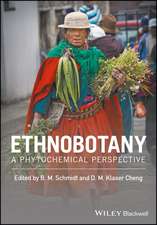Plant Salt Tolerance: Methods and Protocols: Methods in Molecular Biology, cartea 913
Editat de Sergey Shabala, Tracey Ann Cuinen Limba Engleză Hardback – 16 aug 2012
Authoritative and easily accessible, Plant Salt Tolerance: Methods and Protocols serves as an essential read for every student or researcher tackling various aspects of the salinity problem.
| Toate formatele și edițiile | Preț | Express |
|---|---|---|
| Paperback (1) | 956.81 lei 6-8 săpt. | |
| Humana Press Inc. – 23 aug 2016 | 956.81 lei 6-8 săpt. | |
| Hardback (1) | 659.70 lei 6-8 săpt. | |
| Humana Press Inc. – 16 aug 2012 | 659.70 lei 6-8 săpt. |
Din seria Methods in Molecular Biology
- 9%
 Preț: 791.59 lei
Preț: 791.59 lei - 23%
 Preț: 598.56 lei
Preț: 598.56 lei - 20%
 Preț: 882.95 lei
Preț: 882.95 lei -
 Preț: 252.04 lei
Preț: 252.04 lei - 5%
 Preț: 802.69 lei
Preț: 802.69 lei - 5%
 Preț: 729.61 lei
Preț: 729.61 lei - 5%
 Preț: 731.43 lei
Preț: 731.43 lei - 5%
 Preț: 741.30 lei
Preț: 741.30 lei - 5%
 Preț: 747.16 lei
Preț: 747.16 lei - 15%
 Preț: 663.45 lei
Preț: 663.45 lei - 18%
 Preț: 1025.34 lei
Preț: 1025.34 lei - 5%
 Preț: 734.57 lei
Preț: 734.57 lei - 18%
 Preț: 914.20 lei
Preț: 914.20 lei - 15%
 Preț: 664.61 lei
Preț: 664.61 lei - 15%
 Preț: 654.12 lei
Preț: 654.12 lei - 18%
 Preț: 1414.74 lei
Preț: 1414.74 lei - 5%
 Preț: 742.60 lei
Preț: 742.60 lei - 20%
 Preț: 821.63 lei
Preț: 821.63 lei - 18%
 Preț: 972.30 lei
Preț: 972.30 lei - 15%
 Preț: 660.49 lei
Preț: 660.49 lei - 5%
 Preț: 738.41 lei
Preț: 738.41 lei - 18%
 Preț: 984.92 lei
Preț: 984.92 lei - 5%
 Preț: 733.29 lei
Preț: 733.29 lei -
 Preț: 392.58 lei
Preț: 392.58 lei - 5%
 Preț: 746.26 lei
Preț: 746.26 lei - 18%
 Preț: 962.66 lei
Preț: 962.66 lei - 23%
 Preț: 860.21 lei
Preț: 860.21 lei - 15%
 Preț: 652.64 lei
Preț: 652.64 lei - 5%
 Preț: 1055.50 lei
Preț: 1055.50 lei - 23%
 Preț: 883.85 lei
Preț: 883.85 lei - 19%
 Preț: 491.88 lei
Preț: 491.88 lei - 5%
 Preț: 1038.84 lei
Preț: 1038.84 lei - 5%
 Preț: 524.15 lei
Preț: 524.15 lei - 18%
 Preț: 2122.34 lei
Preț: 2122.34 lei - 5%
 Preț: 1299.23 lei
Preț: 1299.23 lei - 5%
 Preț: 1339.10 lei
Preț: 1339.10 lei - 18%
 Preț: 1390.26 lei
Preț: 1390.26 lei - 18%
 Preț: 1395.63 lei
Preț: 1395.63 lei - 18%
 Preț: 1129.65 lei
Preț: 1129.65 lei - 18%
 Preț: 1408.26 lei
Preț: 1408.26 lei - 18%
 Preț: 1124.92 lei
Preț: 1124.92 lei - 18%
 Preț: 966.27 lei
Preț: 966.27 lei - 5%
 Preț: 1299.99 lei
Preț: 1299.99 lei - 5%
 Preț: 1108.51 lei
Preț: 1108.51 lei - 5%
 Preț: 983.72 lei
Preț: 983.72 lei - 5%
 Preț: 728.16 lei
Preț: 728.16 lei - 18%
 Preț: 1118.62 lei
Preț: 1118.62 lei - 18%
 Preț: 955.25 lei
Preț: 955.25 lei - 5%
 Preț: 1035.60 lei
Preț: 1035.60 lei - 18%
 Preț: 1400.35 lei
Preț: 1400.35 lei
Preț: 659.70 lei
Preț vechi: 776.13 lei
-15% Nou
Puncte Express: 990
Preț estimativ în valută:
126.25€ • 130.42$ • 105.07£
126.25€ • 130.42$ • 105.07£
Carte tipărită la comandă
Livrare economică 25 martie-08 aprilie
Preluare comenzi: 021 569.72.76
Specificații
ISBN-13: 9781617799853
ISBN-10: 1617799858
Pagini: 448
Ilustrații: XIV, 432 p. 56 illus., 26 illus. in color.
Dimensiuni: 178 x 254 x 30 mm
Greutate: 0.95 kg
Ediția:2012
Editura: Humana Press Inc.
Colecția Humana
Seria Methods in Molecular Biology
Locul publicării:Totowa, NJ, United States
ISBN-10: 1617799858
Pagini: 448
Ilustrații: XIV, 432 p. 56 illus., 26 illus. in color.
Dimensiuni: 178 x 254 x 30 mm
Greutate: 0.95 kg
Ediția:2012
Editura: Humana Press Inc.
Colecția Humana
Seria Methods in Molecular Biology
Locul publicării:Totowa, NJ, United States
Public țintă
Professional/practitionerCuprins
Patch-Clamp Protocols to Study Cell Ionic Homeostasis under Saline Conditions.- Studying Plant Salt Tolerance with the Voltage Clamp Technique.- Using the Multifunctional Xylem Pprobe for In situ Studies of Plant Water and Ion Relations under Saline Conditions.- Measuring Intracellular Ion Concentrations with Multi-Barrelled Microelectrodes.- Single-Cell Sampling and Analysis (SiCSA).- Non-Invasive Flux Measurements Using Microsensors: Theory, Limitations and Systems.- Quantifying Kinetics of Net Ion Fluxes from Plant Tissues by Non-Invasive Microelectrode Measuring MIFE Technique.- Quantitative Cryo-Analytical Scanning Electron Microscopy (CEDX): An Important Technique Useful for Cell-Specific Localization of Salt.- Fluorescence Lifetime Imaging (FLIM) Measurements in Salinity Research.- Cytosolic Ca2+ Determinations in Studying Plant Responses to Salinity and Oxidative Stress.- Infrared Thermography in Plant Phenotyping for Salinity Tolerance.- In vivo Imaging of Nitric Oxide and Reactive Oxygen Species Using Laser Scanning Confocal Microscopy.- Metabolomics for Salinity Research.-Purification of Plant Plasma Membranes by Two-Phase Partitioning and Measurement of H+ Pumping.-Determination of Reactive Oxygen Species in Salt-Stressed Plant Tissues.-Quantification of the Antioxidant Activity in Salt-Stressed Tissues.-Quantification of Abscisic Acid, Cytokinin and Auxin Content in Salt-Stressed Plant Tissues.-Fluorescence-Activated Cell Sorting for Analysis of Cell Type-Sspecific Responses to Salinity Stress in Arabidopsis and Rice.-Transformation Using Controlled cDNA Overexpression System.-Transcriptome Analysis of Membrane Transporters in Response to Salinity Stress.-Marker-Assisted Selection in Plant Breeding for Salinity Tolerance.-Transcriptomics on Small Samples.-Plastid Transformation for Abiotic Stress Tolerance in Plants.-Manipulating Expression of Tonoplast Transporters.-Using Heterologous Expression Systems to Characterize Potassium and Sodium Transport Activities.-Isotope Techniques to Study Kinetics of Na+ and K+ Transport Under Salinity Conditions.-Trait Dissection of Salinity Tolerance with Plant Phenomics.-Measuring Soil Salinity.
Textul de pe ultima copertă
Soil salinity is destroying several hectares of arable land every minute. Because remedial land management cannot completely solve the problem, salt tolerant crops or plant species able to remove excessive salt from the soil could contribute significantly to managing the salinity problem. The key to engineering crops for salt tolerance lies in a thorough understanding of the physiological mechanisms underlying the adaptive responses of plants to salinity. Plant Salt Tolerance: Methods and Protocols describes recent advances and techniques employed by researchers to understand the molecular and ionic basis of salinity tolerance and to investigate the mechanisms of salt stress perception and signalling in plants. With chapters written by leading international scientists, this book covers nearly 30 different methods, such as microelectrode and molecular methods, imaging techniques, as well as various biochemical assays. Written in the highly successful Methods in Molecular Biology™ series format, chapters contain introductions to their respective topics, lists of the necessary materials and reagents, step-by-step, readily reproducible laboratory protocols, and notes on troubleshooting and avoiding known pitfalls.
Authoritative and easily accessible, Plant Salt Tolerance: Methods and Protocols serves as an essential read for every student or researcher tackling various aspects of the salinity problem.
Authoritative and easily accessible, Plant Salt Tolerance: Methods and Protocols serves as an essential read for every student or researcher tackling various aspects of the salinity problem.
Caracteristici
Includes cutting-edge methods and protocols Provides step-by-step detail essential for reproducible results Contains key notes and implementation advice from the experts











